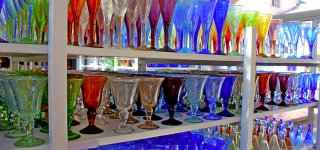Village of Biot and glass
Minutes from the Mediterranean coast, on the French Riviera between Cannes and Nice, the village of Biot is a long and rich history and a prestigious heritage. The old town is lively terraces of friendly bars and restaurants Provence, while in the countryside watered by La Brague nest two gorgeous golf course.
The historic center of Biot testifies to the past of the city, in turn stronghold of the Knights Templar and the Knights of Malta. The old town is enclosed by walls and fortified gates. The visit by strolling stroll along the cobbled streets, freely, with an audio guide or in the company of a local guide. Among the attractions of the city include the square arcades, 13th and 14th centuries, and in soil cobbled galleries, the fortified gates of Migraniers and Tines dating both from the 16th century, or the newest oven communal bread from 1930, regularly returned to service on the occasion of various events in the city. It is designed in stone cinérite known for their refractory qualities and from the same quarries of Biot.
The Church of St. Mary Magdalene Biot was built from the 15th to 16th century on the remains of a Romanesque church of the 12th century, itself built on the foundations of a Roman temple. It is distinguished by the presence of two towers and the stairs down to the nave from the main entrance.
Very famous for its glass, Biot carries the label of City and Crafts: famous for its jars in the 14th century, Biot into the history of art glass with the opening of a glass school on his territory in 1956. in 1960, the artist develops Torun in Biot its contemporary jewelery collections. Today, more than 50 creators are living the town of Biot, in various crafts including leather goods, jewelry, sculpture and painting. traditional and contemporary inspirations methods meet in Biot each workshop.
The Museum of History and ceramic Biot is the ideal place to discover the long artisanal and artistic tradition of the village. Located in the White Penitents chapel and the former St. Jacques hospital, this museum is rich with an exceptional collection of photographic documents, testimonies and antiques: jugs that artisans of Biot exported worldwide from the 16th century and especially during the 17th and 18th centuries; but also glazed ceramic fountains, Biot specialty from the 18th to 20th century.
The village also houses the prestigious Fernand Léger National Museum, exclusively dedicated to the work of the artist who has lived in Biot. The museum garden is a place of calm and refreshing walk, exposing outdoor monumental works inspired by the work of the artist. The facade of the building designed by Russian architect André Svechin is adorned with giant mosaics. The Fernand Léger museum houses a permanent collection of works by artists ranging from early 20th century to the 50s therefore discovers its evolution and its different periods, from Impressionism to Cubism through biomorphism, the American period, the series manufacturers or ceramics.
The charming village of Biot character finally has a privileged environment at the heart of the regional park of the Brague: 5 hiking loops around Biot through typical Mediterranean landscape between scrubland, holm oak forest and pine forest. They help to meet the rural heritage of Biot old mills, quarries cinérite, or Roman relics.
